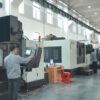What is 3D printing?
The technology of 3D printing, which was proposed as early as the 19th century, is not a new concept. Its development mainly depends on the progress of materials.
Ordinary printer: A layer of ink is sprayed onto the paper’s surface to form a two-dimensional image.
3D printing: It is a “bottom to top” stacking layer by layer, and the powder particles coming out of the nozzle are continuously cured under the action of a binder. (There are also many kinds of materials and molding techniques, such as “laser sintering,” “inkjet,” “deposited molding,” etc. The materials are liquid, wire, and solid powder).
This kind of material is continuously added and then solidified to get what you want, called additive manufacturing. You can think of it as building a house.
What is CNC machining?
CNC is the abbreviation of (Computer Numerical Control), which means: computer numerical control. And CNC machine tools are just one of them. CNC machine tools can process complex, precise, and various parts. It uses a computer-specified program to remove excess materials through cutting, milling, and other steps to achieve the final product, which is also typical subtractive manufacturing. You can think of it as carving art.
What are the advantages of 3d printing?
- No waste of materials
Because it is additive manufacturing, no excess waste will be generated, which saves materials compared to CNC.
3D printing is like building a house: the materials are calculated well in the early stage, and there will be no extra bricks and cement than this. Even if there is, it can be used next time.
CNC machining is like engraving: prepare a piece of wood, engrave it in one go, and at the end, there will be a lot of sawdust, which is unusable, resulting in waste.
The speed of making prototypes is fast
Printing a prototype usually takes a few hours to complete from boot to finished product, and the development cycle is significantly shortened. No need to open the mold, the prototype can be printed directly and quickly, and the cost is reduced considerably. In terms of dimensional accuracy, it can also meet industrial-grade assembly requirements. The dimensional accuracy of plastic samples can reach ±0.1mm, and the dimensional accuracy of metal samples can reach ±20μm.
High flexibility
3D printing has more room to play in the structure of processed parts.
3D printing is like building a house; it has a natural advantage in machining parts with complex structures. For example, hollow parts, as the name suggests, are complex with many holes and grooves. There are also multi-surface, multi-right, beveled parts.
Simple post-processing
The post-processing of 3D printing is relatively simple: sanding and polishing or sandblasting the surface can take less time. There are many issues to be considered in CNC post-processing: material properties, structural shape, size, and so on.
3D printing vs CNC machining
| 3D printing | CNC machining |
Manufacturing principle | Additive Manufacturing | Subtractive Manufacturing |
material utilization rate | high | No high |
Process characteristics | 1.Can process various complex surfaces and special-shaped structural parts. 2.One time molding. 3.No clamps required. | 1.Ordinary CNC machine tools cannot process parts with complex shapes or special-shaped structures. 2.Forming multiple times. 3.Professional engineers are required to design programming and fixture use. |
Manufacturing difficulty | 1. Import the .STL format file to print without the need for staff on duty. 2. Multiple parts can be printed at once, as long as the tray size is large enough. | 1. Professional programmers and engineers are required. 2. Only one part can be machined at a time. |
type of material | 1. There are many colors to choose from. 2. Most of them are made of plastic, and their comprehensive performance is higher than that of photosensitive resin or other materials. | 1.There are significantly more options for metal materials than for 3D printing. |
What fields does 3D printing involve?
- Medical field: 3D printing bones, organs, blood vessels, etc.; some have been applied to clinical medicine and achieved good results. For example, 3D printing the ossicles that transmit external sounds to the cochlear nerve to help people with hearing impairments hear sounds even without hearing aids.
- Aerospace field: Wind tunnel test is an indispensable and essential part of the space shuttle. The parts required in the process have high precision requirements, complex shapes, and streamlined characteristics. 3D printing can play a significant role in manufacturing these parts.
- Electronics field: With the development of 3D printing, foreign researchers have used micro-stereolithography technology to make millimeter-scale polymers made of back-ionic liquids. Engineers could use this technique to print conductive electronic parts.
- Construction field: 3D house building fever can print the house that humans want in just a few hours. The principle of printing is to use recycled materials to make the ink needed for printing. As long as you have the shape you have conceived, the machine can print it.







